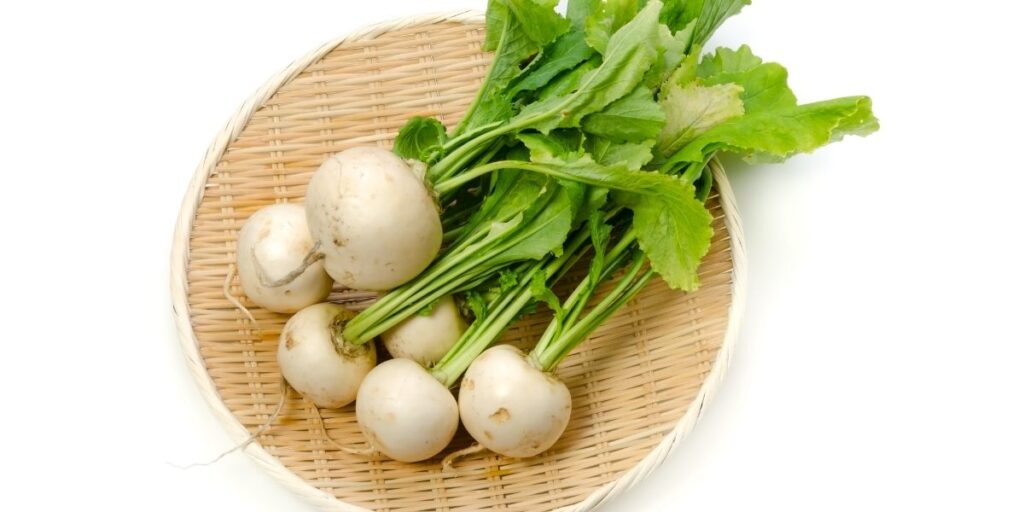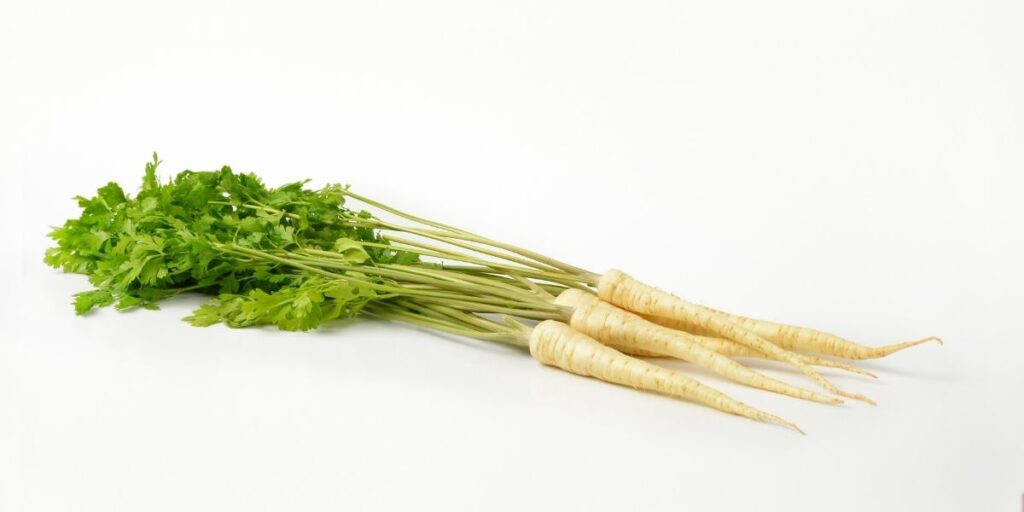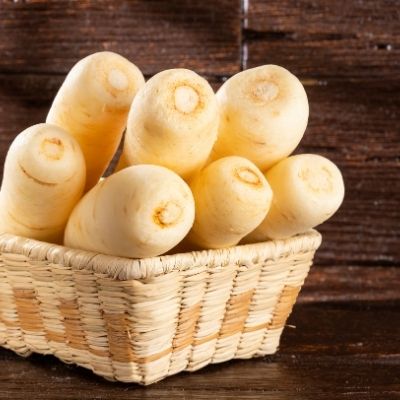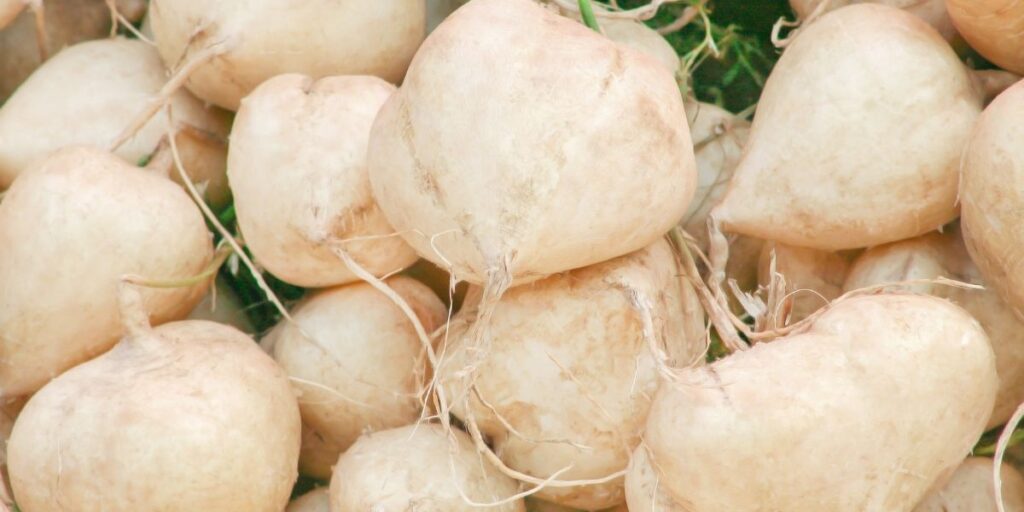by Daisy Dao
Parsnips are a hearty and healthy vegetable popular in Europe and Asia. It has been around since Roman times and was introduced to the people of America in the United States in the 1600s.
They typically get harvested during fall and winter, and because of this, it has become a popular winter vegetable in many parts of Eurasia. In fact, they are often part of the family British Sunday Roast, and many families can’t do without them.

After learning a bit about the history and their popularity as vegetables in parts of the world, let us get into further details about this vegetable.
Parsnip has a cream-colored exterior and a white interior, and they look like carrots in shape. But unlike a carrot, they have a thin layer of skin that you can peel easily to reveal the white flesh.
They have an earthy sweet taste with a kind of honey-like flavor, and their raw texture is also similar to a carrot. It is safe to eat them raw. Their sweet taste intensifies when you roast them.
They are closely related to parsley and carrot, hence the similarity. It also grows underground, making them a root vegetable. Their taproots grow and become mature to provide that sweet flavor.
Parsnips are about 80 percent water, but they have enough vitamins and minerals to meet the daily nutritional amount. They are mostly rich in potassium; other than that, they have many B-group vitamins and vitamin c present.
There are also many nutrients in the skin, so nothing is a waste. They are also full of antioxidants.
Like most root vegetables, they are versatile and can go along with most dishes and appetizers. There are many recipes from around the world with them being used as a side dish.
In many Asian countries, they add it to their soup, which is a side to the rice. You can puree it to make a mash as a side to meats like chicken or beef, add it to your salads, make stir-fries, and so much more.
If you don’t like the taste of parsnip or it isn’t available where you live, these are the best parsnip substitutes to add to your main dishes, side dishes, soups, salads, and stews.

Turnips are another winter vegetable. They can be a bit hard to find, but you can usually find them in most grocery stores in winter.
Unlike parsnips, turnips are a much milder tasting root vegetable, which makes them versatile to stir fry, bake, boil, steam, or eat raw. But you do have to add more seasoning to them since they don’t have a distinct flavor.

Celery root or celeriac is light earthy colored root vegetables that resemble a turnip along with having the flavor profile of one as well. So they don’t taste as close to parsnip but can work perfectly as an alternative in many dishes, including soups, stews, etc.
They are very fibrous, like celery, so you need to boil them much longer than the others to get a good soft texture. This way, you can mash it to create a side dish. Most grocery stores only sell celeries, so it can be difficult to find them other than in organic markets.

Parsley root is almost identical looking to parsnips, which can get a little confusing. Not only that, but they also have a very similar starchy and sweet flavor profile, making them excellent parsnip substitutes. Plus, they have a very pleasant aroma that adds another layer to any food.
You can also eat them raw, and they have a similar crunchy texture to when you bite celery. But they are better off being cooked, either roasted, baked, or fried. However, the biggest downside with them is that they are almost impossible to find other than on a farmer’s market or grown by yourself.

Among the other substitutes here, salsify is probably the least popular and known. However, they are quite versatile, and you can add and make many dishes out of them. Salsify or salsify roots look almost like tree branches. They are brown in color on the outside and are long and slender like a branch.
The inside of it is a creamy white, and when cooking the flesh, it tastes very similar to an oyster, which is why they are also called oyster plant. Their skin is quite thick and hard to peel, so it is easier to boil and then remove them.
It is more popular in Europe than in other parts of the world. Still, they are quite easy to find anywhere in grocery stores, supermarkets, farmers’ markets, etc. Europe views them as a winter vegetable to use as ingredients in their soups and stews.
Sweet potatoes, the cousin of the potato family, come in two varieties. One is deep orange in color with thick skin; the other is a lighter shade or yellowish. Out of the two, the dark orange is sweeter.
Their texture is very similar to potatoes, the same starchy creamy texture, especially when boiled. Sweet potatoes can work to replace parsnips in salads, creamy stews, soups, and more. You can also make mashed potatoes with butter to make a side dish; it goes well as a snack with cream or a cup of milk.
Out of all we have mentioned so far, sweet potatoes are the easiest to find year-round. They are also very popular worldwide with many recipes and are used in many different cuisines.
As we mentioned before, parsnips are closely related to the carrot, so you saw this coming. Firstly carrots have an almost identical shape and size to a parsnip. They also share the same crunchy sweet texture and flavor when eaten raw, although carrots are sweeter.
Parsnips can be more difficult to eat raw, unlike carrots, but both taste very similar when cooked. Carrots are also the most popular and common root vegetables on this list, so you probably already know how you can use them in dishes. You can use it as an alternative to parsnips on any dish or food.

Arracacha is a popular root vegetable in South America, so people in Asia may be unaware of its existence. They are native to the Andes and also called the “Peruvian parsnip.”
It is better eaten after cooking, and it tastes like a combined flavor of a carrot and celery. Also, due to its slightly nutty taste, many people use it as ingredients for filling in dumplings, pastries, and gnocchi. Arracacha also tastes great fried, boiled, and baked.
They grow abundantly in Brazil and other warm and humid areas. So, unfortunately, you most probably won’t find them anywhere in your local grocery stores or farmer’s market and may have to buy them online.

Jicama is a popular tuberous root vegetable from Mexico. They are also known as the Mexican turnip as they do have the same shape and size as a turnip. It is unknown to many people around the globe but now has slowly spread to Asia and the Philippines.
They have a crunchy and kind of juicy texture, and you can eat it raw. Contrast to their white flesh; they have a dry and papery skin layer. The mild flavor of jicama makes it ideal for salads, stir-fries, fries, and many other dishes.
Lastly, we have rutabagas or swede, which is also called a “Swedish turnip”. They are known as a cross between a cabbage and a turnip.
Although they have a mild flavor and can be eaten raw, they can taste a bit bitter when you cook them. Rutabagas’ raw taste is fine, and they, in fact, have a pleasantly sweet and buttery taste.
These make great mashed and roasted dishes. You can also fry and bake them.
Appearance and taste wise, parsley root and carrot are probably the most similar to parsnips. Otherwise, there are turnips, celeriac, salsify, and many other vegetables that are similar to a parsnip.
Yes, carrots are great substitutes for parsnips. They are both mildly sweet and have a similar texture, both raw and cooked. Both are also quite versatile.
There are some similarities, as both of them have a starchy flavor and texture, especially when boiled. While potatoes may be a far reach for a parsnip substitute, you can say parsnip can be considered a good substitute for potatoes.
Daikon might not be a good substitute for parsnip due to the higher water content in daikons. They share a similar crunchy texture when raw but flavor-wise, they are not the most ideal. But daikons aren’t a bad substitute when cooked. Beets are another example of that.
No, root vegetables like parsnips, turnips, and carrots are high in carbohydrates, so you can’t add them to your low carb Keto.
We hope you found a good substitute for parsnips to add to your diet. All the vegetables listed are rich in nutrients, so you can try different recipes without compromising. Place them in the refrigerator to keep them fresh for a long time.
 |
 |
 |
 |
 |
 |
 |
 |

About Daisy Dao
Daisy grew up on the beautiful Honolulu island where she often found herself spending most of her day enjoying the ocean scent in sea waves. As such, Daisy came to appreciate the art of cooking seafood. She has experimented with baking, roasting, broiling, poaching, grilling (and every other cooking technique you can think of); and with all kinds of spices too. Now she is ready to present her experience: the art of cooking healthy food without any pre-packaged ingredients; food product recommendations for people who need a bit more guidance on what goes into their bodies; how to maintain an active lifestyle without having to give up your favorite foods!
Kitchen Goodness
Check for FREE Gifts. Or get our Free Cookbooks right now.
Disable the Ad Block to reveal all the recipes. Once done that, click on any button below
 |
 |
 |
 |